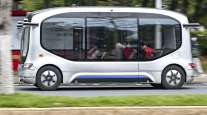Iowa DOT Seeks Volunteers for Self-Driving Car Research
Some of Iowa’s leaders in automated vehicle research are seeking volunteers to help test the results of high-definition mapping and data collection.
It’s been about a year since the Iowa Department of Transportation entered into a roughly $2 million agreement with Chicago’s HERE company to collect data and create the platform that would someday guide autonomous vehicles on Interstate 380 between Iowa City and Cedar Rapids. The University of Iowa and Iowa State University also are involved in the effort.
The project has reached a point where the UI’s National Advanced Driving Simulator, or NADS, needs volunteers to help test the project’s real-time data collection and alert systems.
“This is a great opportunity to sort of be on the front end of what the Iowa DOT is doing. This is unlike a lot of other DOT’s out there in that they want feedback from drivers on the roadway,” said Ashley McDonald, project manager with NADS automated vehicle research. “It is certainly one of the early steps.”
McDonald said the NADS center is seeking 400 volunteers for two testing periods — from Nov. 1 to Dec. 13 and next year from Jan. 17 to Feb. 28. Participants must at least 18 years old and drive five days a week — 50 miles or more in the week — in the testing area, which includes Interstate 380 from Robins to Hills and Interstate 80 from West Branch to Highway 151.
They also must own an Android smartphone, which is necessary to download HERE’s Hazard Alerting app.
Those who complete all of the requirements of the program will be paid $70.
Those interested in participating in the pilot project are encouraged to go to nads-sc.uiowa.edu/safetypilot for additional information.
Participants in the project will need to activate the Hazard Alerting app before their commute. Participants — who will be provided a free car-mount for their phone — will not manually interact with their phones while driving, but rather will receive auditory information regarding hazards along their route. Online surveys will be completed to collect participants’ experiences with the program.
It’s the collection and distribution of that real-time data — which is collected from the DOT and HERE and stored in a cloud-based system — that is crucial to the program, said Scott Marler, director of the Iowa Department of Transportation’s office of traffic operations.
Currently, that data can be used to provide drivers with real-time alerts for cases like work zones, weather, crashes, traffic jams, obstructions and special events.
“By bringing all of this together to this HERE cloud, not only can you centralize everything, but also drivers hopefully are getting more timely alerts so they can be safer on the road, but also have more information and make a better decision,” McDonald said.
Eventually that data could be sent directly to automated vehicle operating systems.
“In the future, we would like for this data to be available to the vehicle itself so the vehicle can begin to make the appropriate lane changes or perhaps prepare to stop or whatever the case may be in terms of what’s happening in real-time on the transportation system,” Marler said.
Distributed by Tribune Content Agency, LLC




